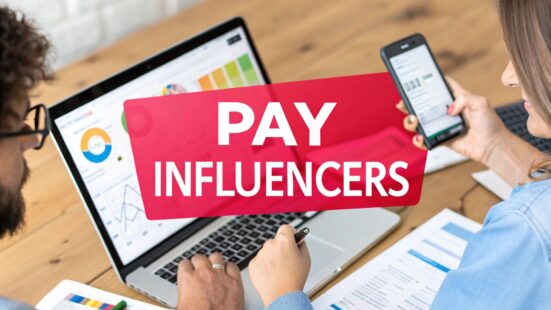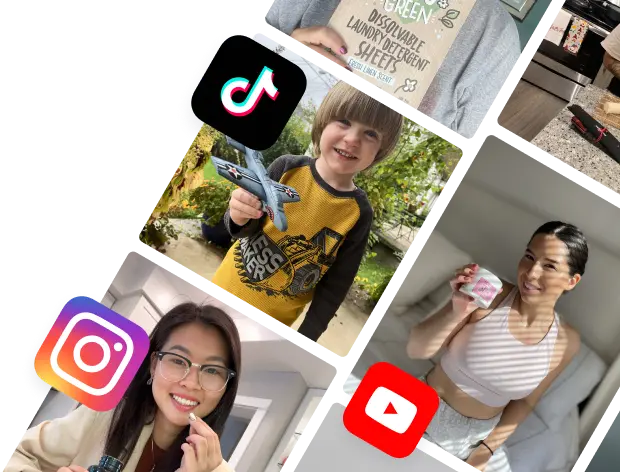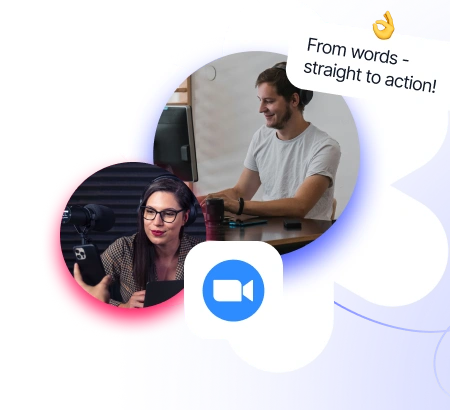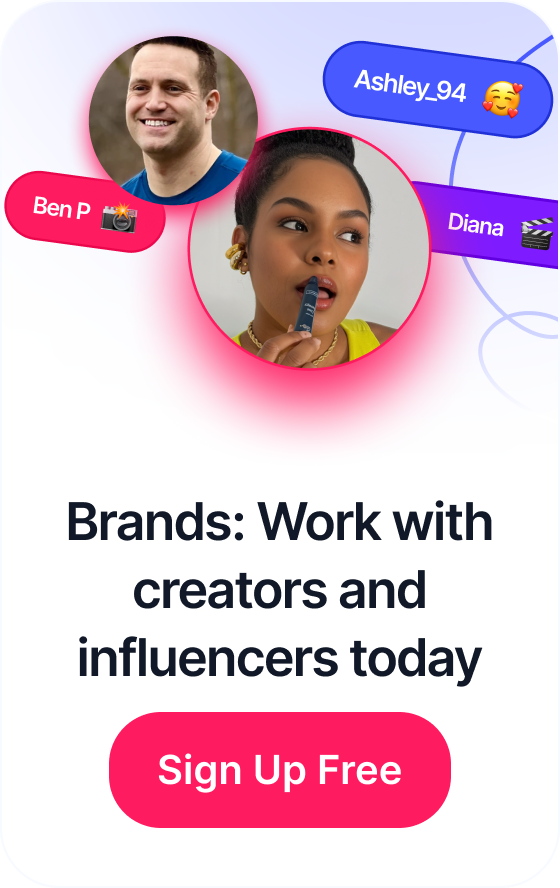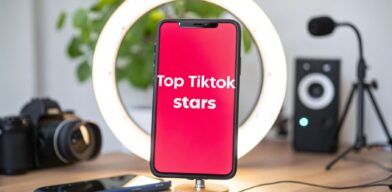 Top TikTok Influencers to Follow in 2025 | Top TikTok Influencers
Top TikTok Influencers to Follow in 2025 | Top TikTok Influencers
Table of Contents
Understanding What Influencers Actually Charge (And Why)
Trying to pin down influencer rates can feel impossible. You see a creator’s follower count and assume that’s the whole story, but it’s rarely the most important part of the equation. The real factors driving the cost are less about audience size and more about the trust they’ve earned, the quality of their content, and what you’re actually asking them to do. Getting a grip on this is the first real step in learning how to pay influencers in a way that makes sense for everyone.
Beyond Follower Counts: The Real Value Drivers
A creator’s rate card is a business proposal, not just a price tag tied to their follower count. A nano-influencer with a super-engaged, niche audience can drive more sales than a mega-influencer whose followers just passively scroll by. You aren’t just buying reach; you’re investing in a creator’s specific connection with their community. Here’s what really shapes their pricing:
- Quality of Engagement: Go beyond likes. Look for genuine comments, shares, and saves. These actions show that the audience is truly paying attention and values the content.
- Audience Alignment: How well does their audience match your ideal customer? A perfect fit is worth paying a premium for because you’re reaching people who are already primed to be interested in your product.
- Content Complexity: A simple static post for Instagram takes far less effort than an edited, multi-clip TikTok or a 15-minute researched YouTube video. The more skill and production time involved, the higher the price.
- Usage Rights: Think about where and for how long you want to use their content. If you plan to run their photo as a paid ad for six months, that will cost more than simply having it on their feed for 30 days.
- Exclusivity: Asking a creator not to work with your direct competitors for a specific period is a standard request, but it limits their income potential, so it rightfully comes with an extra fee.
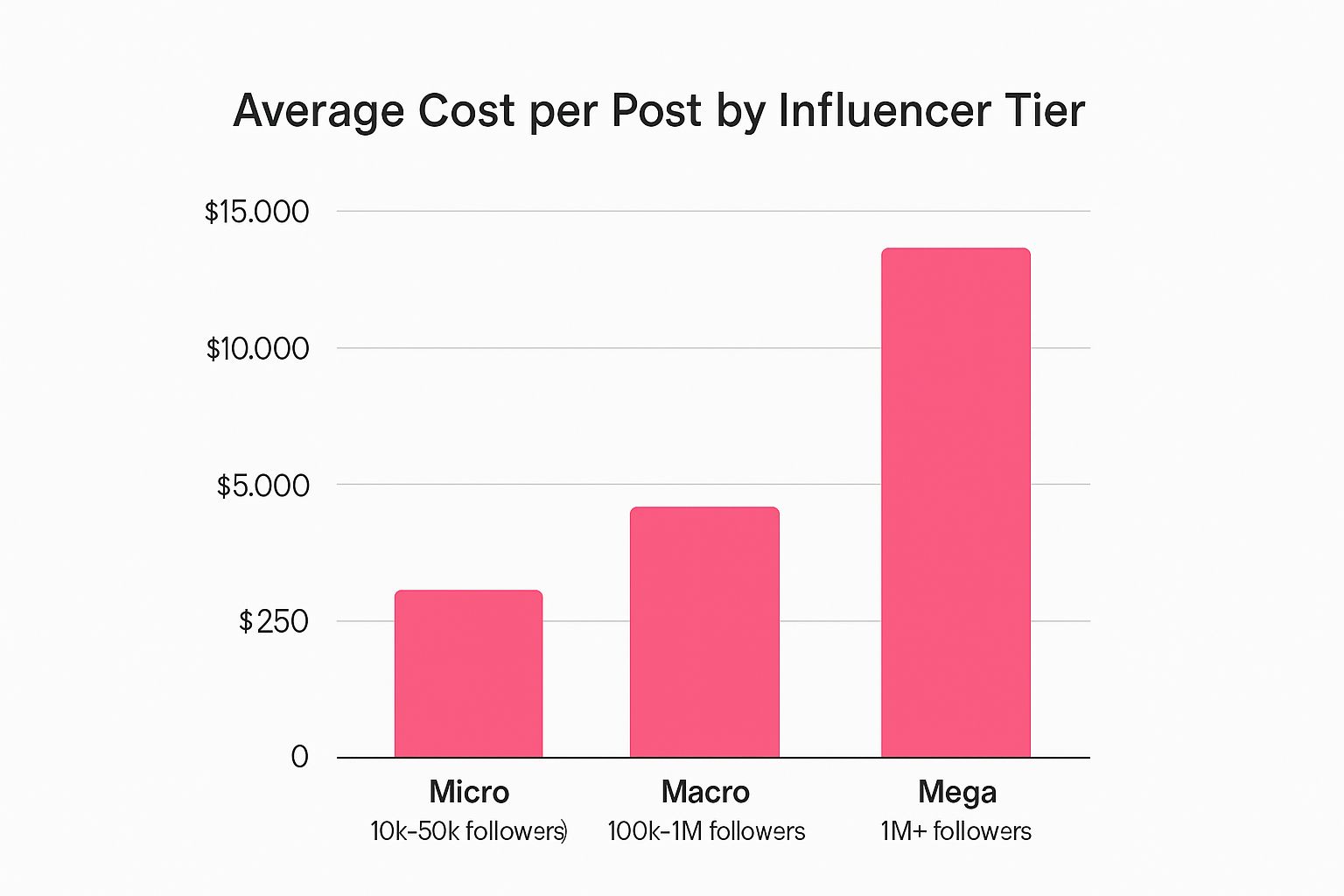
A Look at Real-World Pricing
While the factors above are key, it helps to have some baseline numbers. Remember, these are just starting points. Rates vary wildly based on the creator’s industry, experience, and the specifics of your campaign. The table below gives you a general idea of pricing across major platforms.
Influencer Pricing Breakdown by Tier and Platform
Comprehensive comparison of pricing ranges across influencer tiers and major social media platforms
| Influencer Tier | Follower Range | Instagram Post | TikTok Post | YouTube Video |
|---|---|---|---|---|
| Nano | 1K – 10K | $100 – $500 | $50 – $400 | $200 – $1,000 |
| Micro | 10K – 100K | $500 – $5,000 | $400 – $3,000 | $1,000 – $8,000 |
| Macro | 100K – 1M | $5,000 – $10,000 | $3,000 – $10,000 | $8,000 – $20,000 |
| Mega | 1M+ | $10,000+ | $10,000+ | $20,000+ |
The biggest takeaway here is how much the platform influences the price. A YouTube video commands a much higher rate due to the significant production effort involved, from scripting and filming to editing and promotion.
As you can see, the ranges are huge. The creator economy is booming—it’s expected to hit $24 billion by 2025, a massive jump from $1.7 billion in 2016. This rapid growth means there’s no single, set price list. You can discover more insights into influencer pricing models to see how these trends affect what you’ll pay.
Let’s make this practical. Say you’re a sustainable fashion brand with a $20,000 budget. You could spend it all on one post from a mega-influencer for a quick burst of exposure. Or, you could partner with 40 different micro-influencers in the ethical fashion community for $500 each. The second strategy often delivers far more value: you get authentic stories from passionate creators, a ton of content you can repurpose, and better conversion rates because you’re reaching people in their own trusted communities. It’s about making a strategic investment, not just chasing the biggest follower count.
So, it’s time to stop asking, “How much does an influencer cost?” and start asking, “What is this specific partnership worth to my brand’s goals?” An influencer’s rate isn’t a final price—it’s the start of a negotiation. The best deals happen when both you and the creator agree on the value being exchanged. This focus on mutual benefit is how you build strong, profitable, and long-lasting relationships with creators.
Platform-Specific Payment Strategies That Drive Results

If you’re trying to figure out how to pay influencers, the biggest mistake you can make is treating every social media channel the same. That’s a surefire way to waste your budget. Each platform has its own culture, content style, and financial ecosystem. A smart payment strategy isn’t about one magic number—it’s about matching your offer to the platform. Think about it: a raw, viral-style TikTok video is a world away from a polished, long-form YouTube documentary, and their price tags should be, too.
High-Paced Visuals: TikTok vs. Instagram
At first glance, TikTok and Instagram look like they play in the same league, but their creator economies are completely different animals. TikTok’s algorithm is famous for one thing: it values great content over a huge follower count. A creator with just 5,000 followers can go viral, literally overnight. This changes the payment game. Brands often pay lower base rates on TikTok because they’re betting on the potential for massive reach, not a guaranteed audience. The content is all about speed, trends, and being real, which is why working with smaller creators here can deliver incredible bang for your buck.
Instagram, on the other hand, feels more like a carefully curated portfolio. Here, rates are more predictable and often linked directly to follower counts and the quality of their aesthetic. A polished Instagram Reel or a slick carousel post just takes more effort than a spontaneous TikTok. The pricing shows it. A TikTok nano-influencer might ask for $5 to $25 per post, while a mega-influencer can command over $2,500.
A good rule of thumb for Instagram is about $1,000 per 100,000 followers, though this can go up with higher engagement rates. Here’s a pro tip: about half of creators are open to discounts for multi-post deals, which is a great way to lock in some consistency. If you want to dive deeper, you can explore more data on creator pricing trends to sharpen your budget.
The Investment Platforms: YouTube and LinkedIn
Moving over to YouTube and LinkedIn, you’re looking at a totally different kind of investment. A YouTube video is what we call evergreen content. A solid tutorial or an honest review can keep pulling in views and sending traffic your way for years, long after an Instagram Story has disappeared. The work involved—from scripting and filming to editing and optimizing—is significant, and the price tag matches. You aren’t just buying a one-off post; you’re investing in a marketing asset that keeps on giving.
LinkedIn influencers are in their own league. These aren’t just content creators; they are industry experts, thought leaders, and key decision-makers talking to a professional, B2B crowd. An endorsement on LinkedIn does more than just raise awareness—it builds serious credibility and can sway high-ticket buying decisions. This is why LinkedIn influencers command premium rates. The potential return from just one new client can be huge.
Getting these platform differences is critical. It’s a core part of influencer marketing best practices and shifts the focus from just blasting out offers to making smart, strategic partnerships. This flexible, platform-specific thinking is what separates brands that get real results from those that are just lighting money on fire.
Negotiating Rates Without Burning Bridges
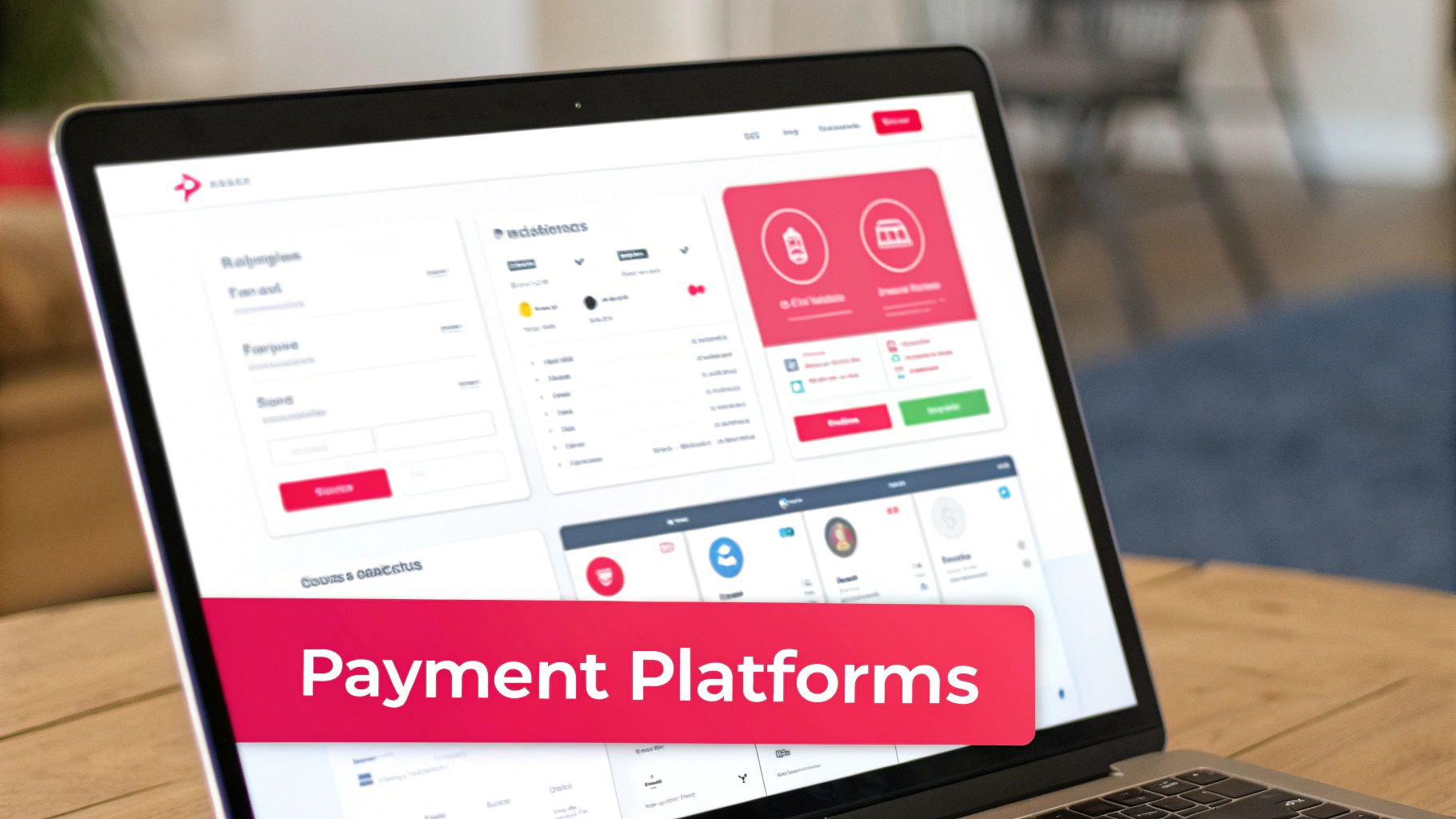
That moment an influencer’s rate card lands in your inbox can feel like a high-stakes standoff, but it really shouldn’t be. The best way to approach negotiation isn’t about winning a price war; it’s about starting a conversation to find a deal that benefits everyone.
Always remember that for a professional creator, this is their business. Their initial quote is usually a carefully calculated number based on their audience engagement, content production efforts, and the results of past campaigns. Showing respect for their pricing is the first step toward building a real partnership.
When to Negotiate (And When Not To)
Before you even consider making a counteroffer, take a moment to ask yourself if the rate is genuinely fair for what you’re asking. Sending a flat-out lowball offer is the fastest way to shut down the conversation and get your brand a bad reputation among creators.
Instead of asking, “Can you do this for 30% less?” which can feel dismissive, try shifting the focus to the deliverables. A much more collaborative and respectful approach is something like, “Our budget for this campaign is X. What kind of package could we build together that fits within that number?” This is transparent about your own constraints while still respecting their value.
More Than Money: Offering Creative Value
While fair cash compensation is the foundation, you can often sweeten the deal with creative value-adds. This is a crucial part of learning how to pay influencers in a way that builds lasting relationships. Many creators, especially those still growing their personal brand, appreciate perks that provide real value beyond a single payment.
To figure out what they might want, it helps to understand how they make their money. Reading up on topics like How To Get Paid On Tiktok Top Monetization Secrets can give you insight into what they truly find valuable.
Here are a few ideas that work well:
- Long-term contracts: Offering a 3 or 6-month retainer gives them stable, predictable income, which is a huge plus for any freelancer.
- Generous product packages: Don’t just send the one product for review. Provide them with extra items for personal use or to run their own giveaways, which helps them engage their audience.
- Cross-promotion: Offer to feature their content on your brand’s social media, in an email newsletter, or on your website. This drives traffic back to their profile and gives them valuable exposure to your audience.
Your negotiation style should also change depending on the influencer’s experience. A chat with a rising nano-creator is going to be very different from a formal discussion with a macro-influencer’s agent.
To help you adjust your strategy, here’s a breakdown of how to approach negotiations with different types of influencers.
Negotiation Strategies by Influencer Tier
Effective negotiation approaches and value-adds for different types of influencers
| Influencer Type | Best Negotiation Approach | Effective Value-Adds | Red Flags to Avoid |
|---|---|---|---|
| Nano | Focus on partnership and mutual growth. Be transparent and educational in your communication. | High-value product seeding, meaningful cross-promotion, and clear long-term potential. | Asking for free content in exchange for “exposure” is a major no-go. |
| Micro | Offer a balanced mix of fair monetary compensation and genuine partnership perks. | Multi-month retainers, creative freedom in briefs, and performance-based affiliate commissions. | Sending lowball offers or providing overly restrictive and stifling creative briefs. |
| Macro & Mega | Be professional, data-driven, and prepared to communicate through an agent or manager. | Co-branded product lines, large-scale campaign opportunities, and paid event hosting gigs. | Wasting their (or their agent’s) time with unrealistic offers or slow, unprofessional communication. |
Ultimately, a successful negotiation isn’t just about the number you agree on. It’s about proving you’re a serious partner who respects their craft and is ready to build something great together.
Payment Methods and Timing That Actually Work
https://www.youtube.com/embed/6QWZXl-qWos
Once you’ve shaken hands on a fair rate, you have to actually get the money into the creator’s hands. This might seem like a simple box-ticking exercise, but how you handle payments speaks volumes about how you value the partnership. Getting this right is a huge part of learning **how to pay influencers** in a way that builds lasting relationships.
Choosing the Right Payment Rails
The specific tool you use to send money matters more than you might think. While there’s no single perfect method, creators definitely have their favorites. PayPal is overwhelmingly popular because it’s fast and easy, but keep an eye on the fees, which can take a bite out of a creator’s payment. For bigger campaigns, a direct bank transfer or ACH can feel more professional and sidesteps hefty fees, but it does require the creator to share their banking details.
This is an area where influencer marketing platforms can be a lifesaver. Many have payment systems built right in, handling everything from invoicing to international currency changes. This is a massive help when you’re working with creators from different countries, as it takes the headache of wire fees and exchange rates off everyone’s plate. Your main goal should be to make getting paid as frictionless as possible for the creator.
The Timing Tactic: When to Pay
Just as important as how you pay is when you pay. Nothing sours a great collaboration faster than a creator having to chase an invoice for weeks. Some large companies operate on Net-60 or even Net-90 terms, but this is a massive burden for an independent creator who has production costs and bills to pay. In the creator economy, Net-30 is a more common standard, but you can do better.
For most campaigns, a 50/50 split is the gold standard. This means paying 50% upfront when the contract is signed, giving the creator the security and cash flow to start working. The final 50% is paid when the content is approved or goes live. This setup protects both of you: you don’t pay in full until the work is done, and the creator doesn’t start a project without a financial commitment. Prompt payments build incredible goodwill and directly affect the quality of the work.
Handling Disputes and Keeping It Professional
Even with the best planning, payment issues can pop up. Maybe there’s a miscommunication about a deliverable, or an invoice gets lost in an inbox. The key is to approach these moments with clear communication and professionalism. Your best defense is always a solid contract that clearly details payment terms, what’s expected, and how you’ll handle disagreements.
When an issue does arise, treat it as a conversation, not a fight. Your sales negotiation skills can be surprisingly helpful here for reaching a fair outcome without ruining the relationship. Also, remember your legal duties. In the U.S., you’re generally required to issue a 1099-NEC form to any creator you pay over $600 within a calendar year.
Contracts That Protect Everyone Involved
While fair payments build trust, a solid contract is the framework that keeps a partnership from falling apart. Going into a campaign without one is like navigating a new city without a map—you might get lucky, but you’re far more likely to get lost. A great contract isn’t about mistrust; it’s a tool for clarity that protects you, the creator, and your investment. It turns a verbal agreement into a professional commitment, a crucial step when figuring out how to pay influencers the right way. A simple handshake deal often leads to miscommunication, missed deadlines, and mutual frustration.
Key Clauses You Can’t Afford to Skip
Think of your contract as the official playbook for the campaign, one that everyone agrees to follow. It should eliminate any guesswork. While you can find templates online, it’s always a smart move to have a legal professional look over your standard agreement.
At a bare minimum, every influencer contract needs to include:
- Detailed Deliverables: Be almost painfully specific here. Spell out the exact number and type of posts (e.g., one Instagram Reel, three static Stories), which platforms to use, and any required tags, links, or handles.
- Firm Deadlines: Lock in the key dates. This includes when to expect the content draft, how long you have for feedback, and the final date the content goes live. This is what keeps your campaign timeline from slipping.
- Payment Terms: Clearly state the total compensation, the payment schedule (a common structure is 50% upfront and 50% on completion), and the method you’ll be using to send the money.
- FTC Compliance: This is absolutely non-negotiable. The contract must require the creator to clearly disclose the paid partnership, usually with #ad or #sponsored, to stay in line with federal guidelines.
Defining Content Ownership and Usage Rights
This is a detail where many brands stumble. Who actually owns the content once it’s made? And what are you allowed to do with it? You have to define this from the start. Generally, you’ll run into two common scenarios:
- Creator License: The influencer keeps the ownership of their content but gives you a license to use it for a specific purpose and a set amount of time. For example, you might get the rights to repost their content on your brand’s social media channels for six months.
- Brand Ownership (Work-For-Hire): You own the content completely and can use it however you want, indefinitely. This is obviously more valuable to you, which means it will cost you significantly more.
Be explicit about how you plan to use the content. If you want to run their photo as a paid Facebook ad, write it in the contract. If you dream of featuring their video on your website’s homepage, put that in the contract, too. Assuming you have these rights can quickly lead to legal headaches and will definitely damage the relationship.
Setting Clear Expectations for Approvals
To avoid creative clashes, your contract should outline the approval process. A process that’s too restrictive can crush a creator’s authenticity—the very quality you’re paying for. A well-designed contract finds a healthy balance.
A fair system often includes a clear timeline for your feedback (e.g., you have 48 hours to provide notes) and sets a limit on revisions (e.g., one major round for big changes and one minor round for small adjustments). This approach respects the creator’s time and effort while making sure the final content aligns with your brand’s message. Ultimately, a thoughtfully written contract is a cornerstone of strong influencer relationship management because it gets everyone on the same page before the work even begins.
Measuring ROI to Justify Every Dollar Spent

Let’s talk about the moment of truth. You’ve sorted out the contracts and sent the payments. Now you have to prove it was all a smart move. If you can’t show a real return, that influencer budget will likely be the first to get cut. This isn’t about collecting feel-good screenshots of likes; it’s about drawing a direct line from your spending to actual business growth. This is how you confidently decide how to pay influencers for your next campaign, using hard data to back up your decisions.
Beyond Likes and Follows: Tracking What Matters
A high like count is great for a momentary confidence boost, but it doesn’t keep the lights on. To see the real impact of a campaign, you have to track metrics that tie directly to your business goals. The objective is to connect an influencer’s post to a customer’s wallet. This process is known as attribution, and it’s your key to proving value.
Here are the numbers that truly matter:
- Conversion Rate: What percentage of people actually bought something using the influencer’s unique promo code or affiliate link?
- Cost Per Acquisition (CPA): How much did it cost to get each new customer? Just divide your total spend on the influencer by the number of new customers they brought in.
- Referral Traffic: How many people clicked through to your site? You can track this precisely by giving each influencer links with UTM parameters.
- Lead Generation: How many new email sign-ups or free trial users did the campaign bring in?
These figures give you concrete proof of what’s working. They change the internal conversation from, “Did people enjoy the content?” to “How much revenue did that content drive?” This data becomes your strongest asset when reporting back to your team or boss.
Calculating and Optimizing Your Return
Once you have that performance data, calculating your Return on Investment (ROI) is pretty simple. The basic formula is: (Revenue from Campaign – Campaign Cost) / Campaign Cost. So, if you paid an influencer $1,000 and their work resulted in $5,000 in sales, you’ve got a 400% ROI. That’s a powerful number to present.
The potential for these kinds of returns is why influencer marketing is growing so quickly. On average, brands can see a return of $4.21 for every dollar spent on Instagram campaigns. A $500 investment in a micro-influencer could realistically generate more than $2,100 in sales, which makes a strong case for why paying creators fairly is simply good business. You can discover the full report on these benchmarks to see how your own campaigns stack up.
Of course, not all value comes from immediate sales. You’re also building brand awareness and positive sentiment. A great way to measure this is by looking at the Customer Lifetime Value (LTV) of customers who came from influencer campaigns. You might find they stick around longer and spend more over time. This approach doesn’t just justify what you’ve already spent; it sharpens your future strategy. By seeing which creators deliver the best results, you can confidently invest more in your top performers, turning your influencer program into a reliable engine for growth. For a more detailed look, our complete guide on measuring your influencer marketing ROI is a great resource.
Building Long-Term Payment Strategies That Scale
So, you’ve successfully run a few one-off influencer campaigns and seen some great results. What’s next? The real magic happens when you start thinking like an investor, not just a one-time buyer. While single projects can give you a nice boost, a scalable, long-term program is what builds serious, unstoppable momentum for your brand.
This is where you move from just buying posts to creating a sustainable marketing engine. The key is to build systems that go beyond simple transactional payments. You want to create an environment where your best creators can grow right alongside your brand, building loyalty and delivering predictable results month after month.
Beyond the Campaign: Models for Lasting Partnerships
To build a program that has staying power, you need payment models that reward commitment. Instead of haggling over every single deliverable, you establish an ongoing relationship that benefits everyone. Ambassador programs are perfect for this, and they typically rely on a couple of key structures.
- Retainer Models: This is one of the most straightforward and effective ways to get consistent content from your go-to creators. You simply agree on a fixed monthly fee for a set number of deliverables. For instance, a skincare brand might put five of its key micro-influencers on a $1,000 monthly retainer each, in exchange for two Reels and four Stories per month. Creators get predictable income, and the brand gets a steady stream of authentic content without constant negotiation.
- Performance-Based Hybrids: This model is fantastic for aligning your goals directly with the creator’s. You can offer a smaller base retainer to provide some security, then add a commission on top. The creator earns a percentage of every sale they generate through their unique affiliate link or discount code. This gives them a powerful reason to create content that doesn’t just get views but actually drives sales.
Both of these models make it much easier to track your campaign outcomes. If you want to get really granular on building campaigns that deliver a solid return, digging into your influencer marketing ROI is the perfect next step.
The Future of Payment: Co-Creation and Equity
For your absolute best-performing and most trusted partners, you can explore deeper collaborations that turn them from contractors into true brand partners. These are advanced strategies, best suited for mature programs where you’ve found creators who truly embody your brand’s spirit and drive amazing results.
A co-creation deal is a powerful option. This is where you work directly with an influencer to design and launch a new product together. Imagine a fitness apparel brand teaming up with a popular athlete to develop a signature line of workout gear. The influencer provides their audience and creative ideas, and in return, they receive a significant percentage of that product’s sales.
The ultimate form of partnership is offering equity. This means giving a top-tier creator a small ownership stake in your company. It’s a massive step, but it creates the highest possible level of brand advocacy. The creator is no longer just promoting a product—they’re personally invested in the success of the entire business, making their endorsement incredibly authentic and powerful.
Key Takeaways for Influencer Payment Success
Thinking about how to pay influencers isn’t just about sending money; it’s about building a genuine partnership. When you get the payment strategy right, you’re not just buying a post, you’re investing in an advocate who will champion your brand authentically. This creates a win-win where creators feel respected and valued, and you see tangible results for your business.
Your Blueprint for Smart Payments
To build a program that lasts, keep these core ideas at the center of your strategy.
- Look Beyond Follower Counts: It’s tempting to be wowed by big numbers, but true value lies in a creator’s engagement and how well their audience aligns with your brand. A micro-influencer with a dedicated following can often deliver better results than a macro-influencer with passive fans.
- Customize Your Offers: Don’t use a cookie-cutter approach. A series of TikTok videos requires a different level of effort—and a different rate—than a single Instagram Story. Show creators you understand their platform by tailoring your offers accordingly.
- Negotiate Like a Partner: Treat rate discussions as a collaboration, not a confrontation. Be respectful and transparent. If your cash budget is tight, get creative with value-adds like free products, exclusive access, or cross-promotion.
- Pay Fairly and On Time: A 50/50 payment split (half upfront, half on completion) is the industry standard for a reason. It builds trust and helps creators manage their cash flow, showing them you’re a professional and reliable partner.
- Put It in Writing: A handshake deal is a recipe for disaster. A clear, detailed contract is non-negotiable. It should spell out all deliverables, content usage rights, payment terms, and deadlines to protect both you and the creator.
- Focus on Real ROI: Likes and shares are nice, but they don’t pay the bills. Track the metrics that actually matter to your bottom line, like conversions and cost per acquisition (CPA), to prove the financial impact of your campaigns.
Common Mistakes That Damage Your Reputation
Avoid these common missteps that can quickly derail a campaign and give your brand a bad name among creators.
- Aggressive Lowballing: Offering a rate that is drastically below a creator’s market value is the fastest way to burn a bridge. Word travels fast in the creator community, and you don’t want to be known as the brand that doesn’t value their work.
- One-Size-Fits-All Payments: Failing to recognize the unique effort required for different platforms or content formats shows a lack of understanding. This can make creators feel like you see them as a commodity, not a partner.
- Skipping the Contract: Operating without a contract leaves your brand completely exposed. What happens if there’s a dispute over who owns the content or how long you can use it? A contract prevents these headaches.
Ultimately, a successful influencer program is built on mutual respect and clear, fair processes.
Juggling all of this—from finding the right creators to managing payments and contracts—can feel overwhelming. JoinBrands is designed to make it all manageable, giving you access to over 250,000 creators and the tools to run your campaigns without the chaos. Ready to build partnerships that actually drive growth? Start your campaign on JoinBrands today.
